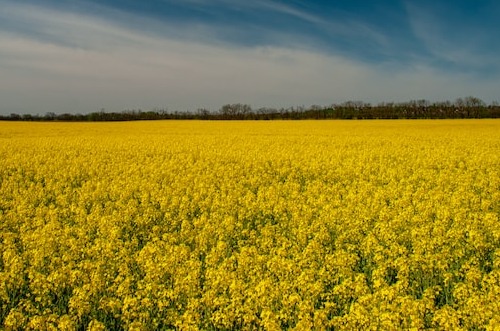W34: Canola & Rapeseed Update

In W34 in the canola landscape, on Monday, August 21, the November futures on the Paris stock exchange fell by USD 5.98/metric ton (mt) to USD 509.57/mt. However, rapeseed futures had rebounded by Friday, August 25, with a 0.4% increase to USD 514.19/mt. Despite this rebound, they remained 25.3% lower year-on-year (YoY) and 0.3% lower week-on-week (WoW). The European Commission (EC) revised its forecast for the 2023/24 rapeseed crop down to 19.1 million metric tons (mmt) from the previous estimate of 19.4 mmt in Jul-23.
In Ukraine, the potential gross harvest of rapeseed in 2023 is poised to achieve a historical high of 4.2 mmt, marking a 5% increase from earlier estimates and a substantial 17% rise from the previous year (2022). This growth is attributed to a 3% YoY expansion in cultivated land, reaching 1.5 million hectares (ha), driven by favorable pricing in the rapeseed market during the prior autumn. The updated forecast for rapeseed exports in the 2023/24 season is approximately 3.8 mmt, indicating a 4% increase from previous estimates. However, challenges persist in shipping oil during the current season due to the suspension of the "grain corridor" and missile attacks on Danube ports.
In Belarus, winter rapeseed was sown in 97% of the planned areas. As of August 25, 90% of the rapeseed were harvested, totaling 6,827 mt. In Moldova, preliminary data reveals varying average yields for wheat, barley, and rapeseed across different regions of the country. Rapeseed yields were 2.6 mt/ha in the Briceni region, 2 mt/ha in the Cahul region, and 2.5 mt/ha in the Hincesti region.
German farmers are facing their worst harvest this year since the 2018 drought due to heavy rains disrupting the harvest process. The yield of winter rapeseed for 2023 stands at 3.51 mt/ha, a significant drop from the previous year's level of 3.96 mt/ha. Despite expanding the rapeseed crop by about 80 thousand ha, the total rapeseed harvest has decreased to 4.07 mmt in 2023 from 4.28 mmt in 2022.
Lastly, in Rio Grande do Sul, Brazil, Conab projects a 49.80% YoY increase in canola planting, with 81,500 ha sown compared to the previous 54,400 ha. Production is expected to reach 101,500 mt, marking a 6.80% YoY rise. This marks the first time in historical records that the harvest is anticipated to surpass 100 thousand mt, compared to an estimated 95 thousand mt in 2022. Furthermore, canola is typically sown between April and May in Rio Grande do Sul, with the main harvest phase taking place from September to October.


